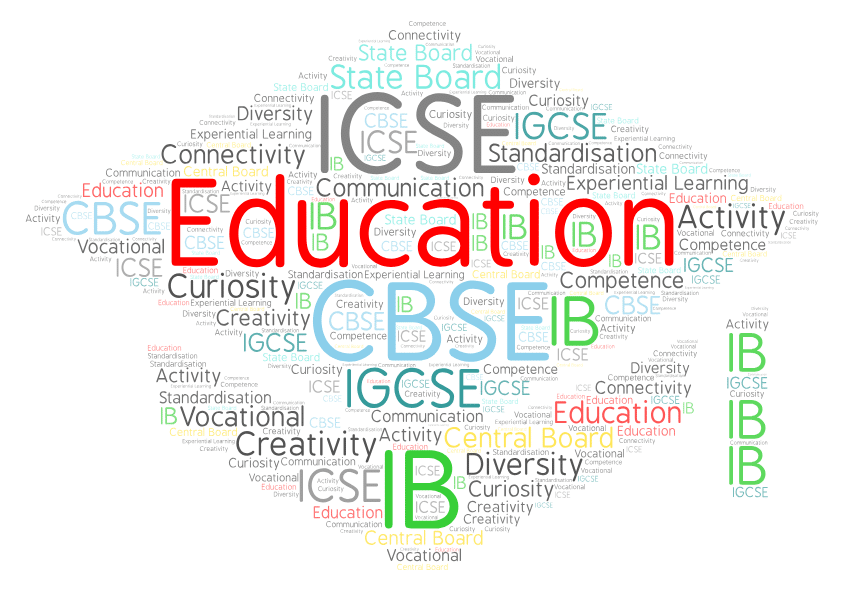In the race of being unique, the current educational bodies have failed to define a standard curriculum, while being critiqued for wiping the creativity out from the individuals during the teaching process. In the light of this argument, a standardised curriculum has different layers. On the other hand, the decision whether it’s essential or harmful, whether it really helps us to become better and responsible citizens, whether it helps us become more successful is still ambiguous and highly context-dependent.
Coming from a state board (CHSE, Odisha), I can share some glaring differences, such as the times when my friends from other boards like CBSE and ICSE were aspiring to join institutions like IIT, AIIMS or NDA (Dehradun). The preliminaries for these institutions were organised by CBSE and their familiarity with the pattern of CBSE curriculum was a decided advantage. On other occasions, I heard them discussing Shakespeare – his poems and characters from his plays – as this was taught in their secondary or higher secondary classes, which I failed to connect with. There are many such examples, but you get the gist.
Besides this, there was exposure to English and efficiency in communication skills, understanding of the CGPA system, as well as the comprehensive understanding of social sciences and so on. All these factors played a great role when one got into college or opted for higher studies. On the other hand, state boards including mine encouraged a study of regional languages and culture, a solid knowledge of relevant topics (own state and regional subjects) and were easy to grasp since the learning was in mother-tongue. Moreover, state boards bring a well-needed diversity in the country.
This can be a never-ending debate whether you choose CBSE or State Board. However, in light of this argument, let’s look at both sides of the coin: the positive and the negative aspects of a standardised curriculum.
(+) The pros of a centralised curriculum
Helps to be more organised and disciplined:
As it is easier to follow a structured curriculum, this helps kids to understand the basic expectations to be met for excellence, no matter which school they attend. Furthermore, a standardised educational system gives access to an equal pedagogy, especially to the students from elementary schools, offers everyone the same start to life, and an equal chance of acquiring the knowledge needed to get to higher grades and college.
Brings consistency across states:
In our increasingly mobile society, kids end up switching schools either in the same city or in a different city. Since schools under different boards follow different educational standards, the student may be behind or ahead of fellow students in a new school. This creates not only inconsistency but also inequality of educational standards. In such cases, a standardised syllabus would help both teachers and students to be on the same page along with neighbouring communities.
Helps make schools and teachers accountable:

The goal of standardisation is to increase the minimum standards in classroom learning and to ensure that everyone receives at least the basic skills and education equally. A predetermined syllabus will help educators to follow a sequence as per their teaching programme.
With a standardised curriculum that gives specific instructions about the subjects to be covered and pattern of assessments to be done, even teachers with lower qualifications can manage to teach effectively.
Definitive expectations:
Students perform better in such a set up as the standardised curriculum focuses on a sense of structure, for instance, a student must learn certain topics in certain time and duration/schedule. The goal is to achieve an education that supports some level of equity i.e., all must acquire the basic expected knowledge and skill-sets right from elementary school up to the higher grades. This also promotes healthy competition among pupils.
“Everyone needs to know in order to be deemed literate in a broader sense than just being able to read,” argues the educator and academic literary critic, Prof. Eric Donald Hirsch, emeritus of education and humanities at the University of Virginia.
In India, several schools and universities have adopted standardised curricula. The higher education sector has led regulators like the University Grants Commission (UGC), All India Council for Technical Education and the Pharmacy Council of India to help to establish a minimum standard of quality.
(-) The cons of a centralised curriculum
Not everyone learns the same:
Everyone has different learning methods, patterns, and attention spans. Since the needs are different, a blanket pedagogy cannot be applied to everyone. However, different learnings can be mitigated with inquiry-based learning, projects, cross-disciplinary learning, personalised learning environments (PLEs) and several other different approaches for the content and teaching methodology.
Kills creativity, innovation, and deep understanding:
Since the centralised curriculum promotes ‘one-correct-way’ of achieving successful outcomes, it severely affects creativity of innovative young minds in solving similar issues in different ways. Hence, a ‘one-size-fits-all curriculum’ not only limits the opportunities for students to new ways of learning but also lowers achievements.
Fails to cater to students from different backgrounds, knowledge and geographical areas:
This is another pressing issue of standard curriculum. Each student comes with a variety of needs and background knowledge, for instance, a student in Kerala will not have the same concepts as a student in UP simply because of the different geographical locations or socioeconomic status. Furthermore, the situational factors make it difficult to determine standardisation in many cases.
Sets a wrong and unhealthy comparison:
Learning should be personalised to meet the academic needs of all students and avoid unhealthy competition. Students should be given flexibility and ingenuity in learning to be able to find their own strengths and weaknesses. A customised syllabus, in fact, a need-based curriculum helps individuals strive for excellence instead of constantly comparing own grades with those of fellow pupils to meet the standards that are set for all. This eventually eliminates the high dropout rate and low graduation rate.
Makes assessment contextual
When assessments are used as a tool in helping students achieve meaningful outcomes, it counts as highly useful. Else it creates learning helplessness among students as they fail to determine their strengths and weakness. The core purpose of assessments should be challenging the gifted students. At the same time offering help and better guidance to low performing students instead of just being a benchmark for a pass or fail.
Stressing on the importance of adapting the curriculum to fit the personal interests of the students and of making the core subjects applicable to real life, academic philosopher Prof. Nel Noddings says, students and teachers [should] construct educational objectives cooperatively. And in addressing personal interests, Noddings believes we might abandon the traditional college-bound curriculum and practices of specialization.
(+) Role of Technology and Experiential Learning in bridging the divide

While it is evident that bridging the gap in terms of curriculum and consistency across boards is going to take some time, technology can come to our rescue. Here are a few ways technology can help:
- A blended-learning-based solution can help students to learn the concepts without being dragged into the intricacies.
- Augmented Reality (AR) based solutions can help students learn and reinforce their learning while using the current curriculum. For example, when this is applied to the content of a state board syllabus, the AR solution can bridge the gap between the content of the state board and that of a nationalised one, by means of activities and immersive content.
- Technology can provide a map of all the boards on a single “platter”. This can help teachers understand the needs and gaps in the learning of students joining from other boards.
- And finally, a Personalised Learning Environment (PLE) can help students learn without the barriers of boards, curricula and states.
This was our rationale for whether standardisation at this level is helpful or harmful. We would like to know your opinion on this.
tl;dr:
Due to its sheer importance, complexity, and context-dependence, the debate over centralised education system always remains polarised. However, the million-dollar question is whether the benefits outweigh the risks or not. Probably, the answers differ from different communities to classrooms, locations to the situation. Technology can help bridge this gap to a great extent.
Parimita Krishna
Latest posts by Parimita Krishna (see all)
- How Personalised Learning can make your kids curious? - 14 June 2019
- What’s new in CBSE and why Experiential Learning is even more relevant? - 31 May 2019
- The Curious Case of Homeschooling in India - 5 April 2019
- Making Maths fun for your kids - 8 March 2019
- Blended Learning: A Perspective on “Learning how to Learn” - 22 February 2019

